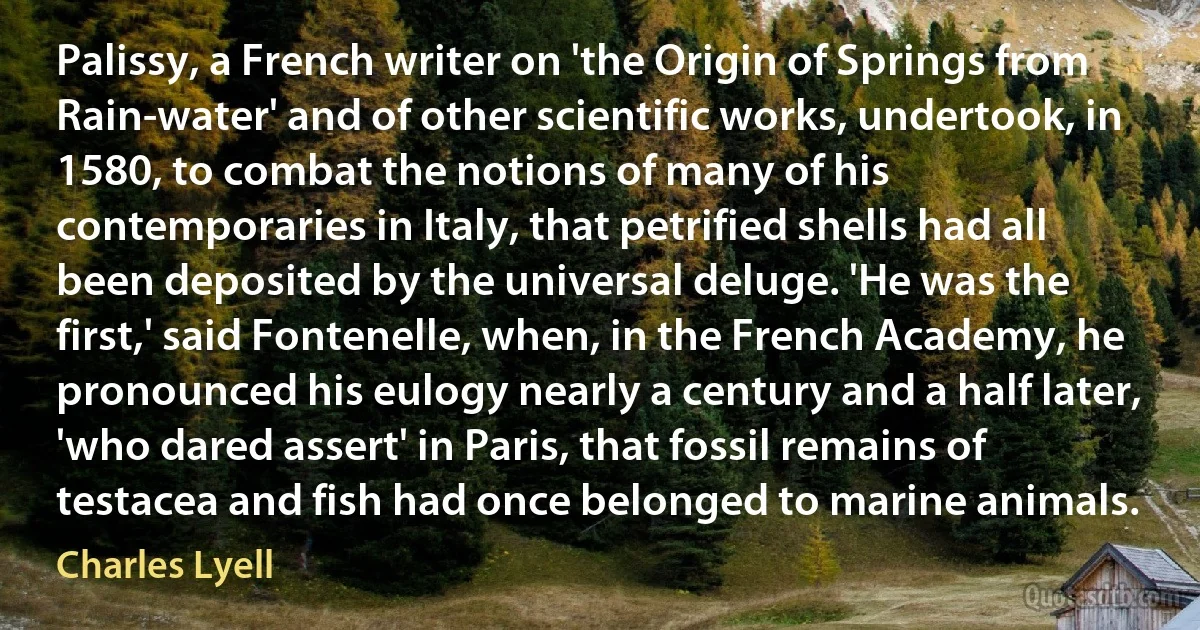Fossil Quotes - page 3
At the core of punctuated equilibria lies an empirical observation: once evolved, species tend to remain remarkably stable, recognizable entities for millions of years. The observation is by no means new, nearly every paleontologist who reviewed Darwin's Origin of Species pointed to his evasion of this salient feature of the fossil record. But stasis was conveniently dropped as a feature of life's history to he reckoned with in evolutionary biology. And stasis had continued to be ignored until Gould and I showed that such stability is a real aspect of life's history which must be confronted-and that, in fact, it posed no fundamental threat to the basic notion of evolution itself. For that was Darwin's problem: to establish the plausibility of the very idea of evolution, Darwin felt that he had to undermine the older (and ultimately biblically based) doctrine of species fixity. Stasis, to Darwin, was an ugly inconvenience.

Niles Eldredge
I have encountered a few "creationists" and because they were usually nice, intelligent people, I have been unable to decide whether they were really mad, or only pretending to be mad. If I was a religious person, I would consider creationism nothing less than blasphemy. Do its adherents imagine that God is a cosmic hoaxer who has created the whole vast fossil record for the sole purpose of misleading humankind? And, although I do not necessarily agree with the paleontologist Teilhard de Chardin's advocacy of evolution as a major proof of the glory of God, de Chardin's attitude is both logical and inspiring. A creator who laid the foundations for the entire future at the beginning of time is far more awesome than a clumsy tinkerer who constantly modifies his creations and throws away entire species in the process.

Arthur C. Clarke
Opponents of Fracastoro met his arguments by feigning imaginary causes, which differed from each other rather in name than in substance. Andrea Mattioli, for instance, an eminent botanist, the illustrator of Dioscorides, embraced the notion of Agricola, a German miner, that a certain 'materia pinguis' or 'fatty matter,' set into fermentation by heat, gave birth to fossil organic shapes. Yet Mattioli had come to the conclusion, from his own observations, that porous bodies, such as bones and shells, might be converted into stone, as being permeable to what he termed the 'lapidifying juice.

Charles Lyell
Quirini, in 1676, contended in opposition to Scilla, that the diluvian waters could not have conveyed heavy bodies to the summit of mountains, since the agitation of the sea never (as Boyle had demonstrated) extended to great depths, and still less could the testacea, as some pretended, have lived in these diluvian waters, for 'the duration of the flood was brief, and the heavy rains must have destroyed the saltness of the sea! He was the first writer who ventured to maintain that the universality of the Noachian cataclysm ought not to be insisted upon. ...Visionary as was this doctrine, it gained many proselytes even amongst the more sober reasoners of Italy and Germany, for it conceded both that fossil bodies were organic, and that the diluvial theory could not account for them.

Charles Lyell
The clear and philosophical views of Fracastoro were disregarded, and the talent and argumentative powers of the learned were doomed for three centuries to be wasted in the discussion of these two simple and preliminary questions: first, whether fossil remains had ever belonged to living creatures; and secondly, whether, if this be admitted, all the phenomena could be explained by the Noachian deluge.

Charles Lyell
We know that the Egyptian priests were aware, not only that the soil beneath the plains of the Nile, but that also the hills bounding the great valley, contained marine shells; and it could hardly have escaped the observation of Eastern philosophers, that some soils were filled with fossil remains, since so many national works were executed on a magnificent scale by oriental monarchs in very remote eras.

Charles Lyell
The theory of the origin of new species by variation will also explain why a species which has once died out never reappears, and why the fossil fauna and flora recede farther and farther from the living type in proportion as we trace it back to remoter ages. It would also account for the fact, that when we have to intercalate a new set of fossiliferous strata between two groups previously known, the newly discovered fossils serve to fill up gaps between specific or generic types previously familiar to us, supplying often the missing links of the chain, which, if transmutation is accepted, must once have been continuous.

Charles Lyell
Scilla, a Sicilian painter, published in l670, a work on the fossils of Calabria, illustrated by good engravings. This was written in Latin, with great spirit and elegance, and it proves the continued ascendency of dogmas often refuted; for we find the wit and eloquence of the author chiefly directed against the obstinate incredulity of naturalists, as to the organic nature of fossil shells.

Charles Lyell
Fabio Colonna deserves to be distinguished; for, although he gave way to the dogma that all fossil remains were to be referred to the Noachian deluge, he resisted the absurd theory of Stelluti, who taught that fossil wood and ammonites were mere clay, altered into such forms by sulfurous waters and subterranean heat; and he pointed out the different states of shells buried in the strata, distinguishing between, first, the mere mould or impression; secondly, the cast or nucleus; and thirdly, the remains of the shell itself. He had also the merit of being the first to point out, that some of the fossils had belonged to marine, and some to terrestrial testacea.

Charles Lyell
Cesalpino, a celebrated botanist, conceived that fossil shells had been left on the land by the sea, and had concreted into stone during the consolidation the soil; and in the following year (1597), Simeone Majoli went still farther, and coinciding for the most part with views of Cesalpino, suggested that the shells and matter of the Veronese, and other districts, might have cast up, upon the land, by volcanic explosions, like those gave rise, in 1538, to Monte Nuovo, near Puzzuoli.- This hint was the first imperfect attempt to connect the position fossil shells with the agency of volcanoes, a system more fully developed by Hooke, [Antonio] Lazzaro Moro, Hutton, and other writers. Two years afterwards, Imperati advocated the animal origin of fossilized shells, yet admitted that stones could vegetate by force of 'an internal principle,' and, as evidence of this, he referred to the teeth of fish, and spines of echini found petrified.

Charles Lyell
I published that theory [of speciational evolution] in a 1954 paper...and I clearly related it to paleontology. Darwin argued that the fossil record is very incomplete because some species fossilize better than others... I noted that you are never going to find evidence of a small local populatlon that changed very rapidly in the fossil record... Gould was my course assistant at Harvard where I presented this theory again and again for three years. So he knew it thoroughly. So did Eldredge. In fact, in his 1971 paper Eldredge credited me with it. But that was lost over time.

Ernst Mayr
So for example, I'm the only candidate which has a policy about how to bring economic opportunity using clean renewable energy as the key into coal country. Because we're going to put a lot of coal miners and coal companies out of business, right? And we're going to make it clear that we don't want to forget those people. Those people labored in those mines for generations, losing their health, often losing their lives to turn on our lights and power our factories. Now we've got to move away from coal and all the other fossil fuels, but I don't want to move away from the people who did the best they could to produce the energy that we relied on.

Hillary Clinton
At the time the Danes decided to back wind power, the cost of electricity produced this way was many times greater than that produced by fossil fuels. The Danish government, however, could see its potential and supported the industry until costs came down. Today Denmark leads the world in both wind power production and the building of turbines; and wind now supplies 21 percent of the country's electricity. One striking aspect of the way that wind power has developed there is that some 85 percent of the capacity is owned by individuals or wind cooperatives, and so power lies in the hands of the people.

Tim Flannery
For generations, we have assumed that the efforts of mankind would leave the fundamental equilibrium of the world's systems and atmosphere stable. But it is possible that with all these enormous changes (population, agricultural, use of fossil fuels) concentrated into such a short period of time, we have unwittingly begun a massive experiment with the system of this planet itself...the increase in the greenhouse gases...has led some to fear that we are creating a global heat trap which could lead to climatic instability.

Margaret Thatcher



